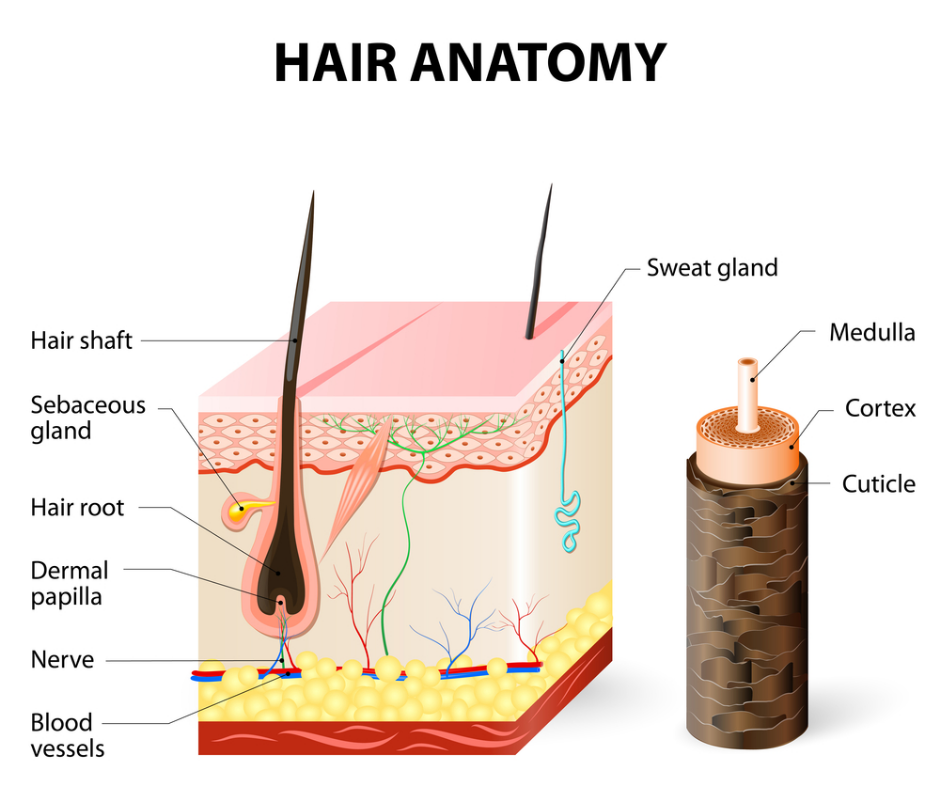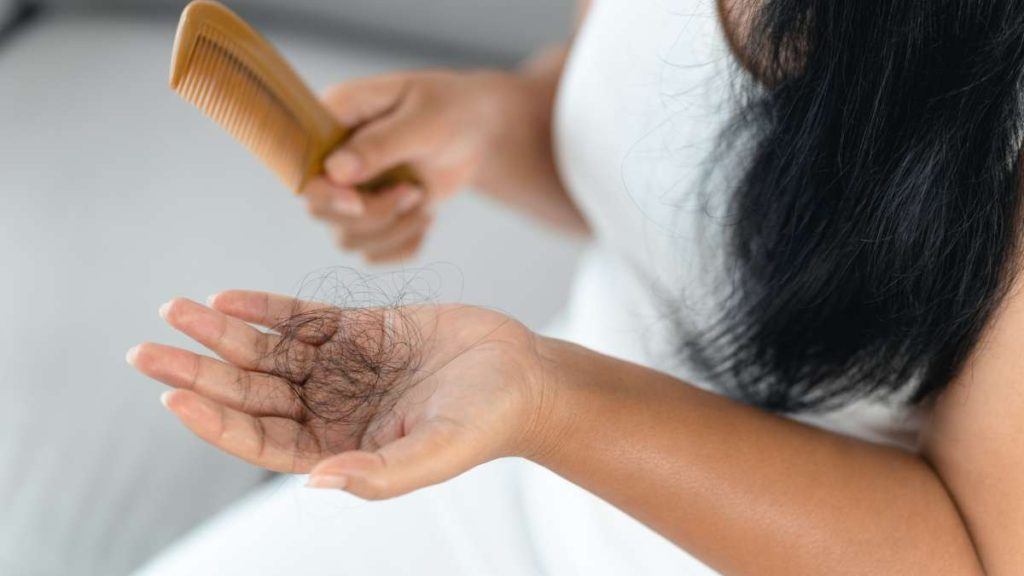Table of Contents
Toggle5 Powerful Solutions for Thyroid and Hair Loss: Understanding Causes and Remedies
Thyroid and Hair Loss – Causes and Solutions
As humans, we value having shiny and healthy hair because it is a noticeable sign of youth and good health. Hair also serves sensory purposes such as shielding us from cold and UV radiation. It’s amazing how much our hair can affect our mood and self-esteem. When the growth or structure of our hair is disrupted, whether it’s thinning, breaking, or just not growing as fast as we want it to, it can have a significant impact on us and can make us feel low. It’s important to take care of your hair and do what we can to keep it healthy and looking its best!
The Hair Structure and Cycle
Hair consists of two parts:
- The Hair Follicle: Located beneath the skin.
- The Hair Shaft: Visible above the skin.
Stem cells at the bulges of the hair follicle play a crucial role in generating the hair follicle and initiating the hair cycle. The hair cycle has three phases:
The Anagen Phase – Growth: This active growth phase lasts up to 2-6 years. On average, 80-90% of your hair is actively growing in the anagen phase. The length of this phase varies between people due to genetics, age, health, and many other factors.
The Catagen Phase – Transition: This is a short period lasting only 2-3 weeks on average and accounts for 2% of all hair. The hair stops growing and detaches itself from the blood supply, becoming club hair.
Telogen Phase – Resting: This is the resting phase of the hair follicles and accounts for 10-15% of all hairs. This phase lasts for around 3 months. The resting club hairs will fall out to allow new hair to come through the hair follicle, and the cycle of the new anagen growth phase begins again.
This is a natural process that should go completely unnoticed. It is normal to lose 50-100 hair strands per day as part of this natural cycle.

Thyroid Hormones and Hair
The thyroid hormone controls cellular metabolism and is responsible for important functions like growth and brain development, gut motility, body temperature regulation, protein synthesis, maintenance of bone structures, and heart rate. Both overactive thyroid (hyperthyroidism) and underactive thyroid (hypothyroidism) disorders can lead to hair loss.
Research studies indicate that the thyroid hormone T4 can stimulate the growth of keratinocytes in the hair matrix and extend the anagen phase of hair growth. Additionally, both T3 and T4 can prevent apoptosis (cell death) in these cells.
If your body has low levels of thyroid hormones, your metabolism may slow down, causing your body to prioritize energy towards maintaining vital functions instead of healthy hair. This could result in hair loss or hair that is brittle or coarse.
Why Do You Lose Hair in Thyroid Disorder?
Low Thyroid Hormone: Hair follicles require essential nutrients and the thyroid hormone plays an essential role in their development and maintenance. When hormone production is disturbed, it can lead to hair thinning across your scalp.
Inflammation: In thyroid disorders, inflammation can destroy hair follicles, causing hair loss.
Mitochondrial Dysregulation: The thyroid hormone (T3) drives the ability to make cell energy. Thyroid hormones help reduce ROS (reactive oxygen species) due to free radicals by biochemical pathways. T3 and T4 induce mitochondrial activity by stimulating keratinocytes.
Reduced Antioxidant Activity: Thyroid hormones increase the activity and expression of antioxidants. When experiencing hypothyroidism, free radicals can accumulate, reducing antioxidant activity and causing inflammation, contributing to hair fall.

Treatment for Hair Loss Caused by Thyroid Disorder
Most cases of scalp and eyebrow hair loss caused by thyroid disorders are temporary, but it may take several months for medication to stimulate hair regrowth, so patience is needed. When treating hair loss caused by thyroid disorders, levothyroxine is commonly used. However, consulting with your doctor regarding your thyroid medication is essential, as incorrect dosages can lead to hair loss.
Important Note: Taking too much Biotin supplement (10mg per day) to boost hair growth can disrupt thyroid test results, leading to misinterpretation of hyperthyroidism due to falsely elevated levels of T3 and T4 in blood work.
Additional Methods to Improve Hair Loss Concerns
Nutritional Insufficiencies: Hair growth requires a lot of energy and several nutrients. Nutrients needed for hair growth include proteins, omega-3 fatty acids, iron, zinc, selenium, and B vitamins (B6, B12, folate, and vitamin C). A balanced diet can provide essential nutrients, but supplements may be necessary if deficiencies exist. Low iron/ferritin levels are a particular problem for those with hypothyroidism. Eating iron-rich foods or taking iron supplements as advised by a medical health practitioner is recommended. Vitamin C-rich foods enhance iron absorption.
Good Quality Protein: Proteins act as building blocks for hair and can help prevent weak, brittle hair. Foods rich in protein include eggs, fish, dairy, lean meats, beans, and legumes.
Anti-Inflammatory Diet: An anti-inflammatory diet helps with hair loss issues. Remove pro-inflammatory foods like processed meat, refined sugar, refined carbohydrates, ultra-processed packaged foods, and sweetened beverages. Eliminate foods that can increase inflammation, such as gluten, dairy, soy, corn, processed meat, and excess sugar if you have food intolerances. Introduce anti-inflammatory foods like green leafy vegetables, colorful vegetables and fruits, spices like turmeric and ginger, and healthy fats from nuts, seeds, and fatty fish. Omega-3 fatty acids are healing to the thyroid gland and reduce inflammation.
Manage Daily Stress Levels: Stress disrupts the hair growth cycle, accelerating the transition from anagen to telogen phase and causing excess hair fall. Prolonged elevated cortisol levels negatively impact the hair cycle. Managing stress is crucial for maintaining hormonal balance and healthy hair.

Conclusion
Experiencing hair loss due to thyroid disease is a common problem, but it can be resolved with the right treatment. If you are experiencing hair loss and it is enough to cause concern, seeking medical advice along with proper nutrition and lifestyle changes is highly recommended to manage this condition. It is unusual for thyroid disease to cause hair loss without other symptoms of an overactive or underactive thyroid. Addressing the issue and taking proactive measures can help avoid potential long-term effects on your physical and emotional health. Prioritizing your health and well-being is essential.
For more insights and comprehensive health guides, visit Nourish Fit.
References:




